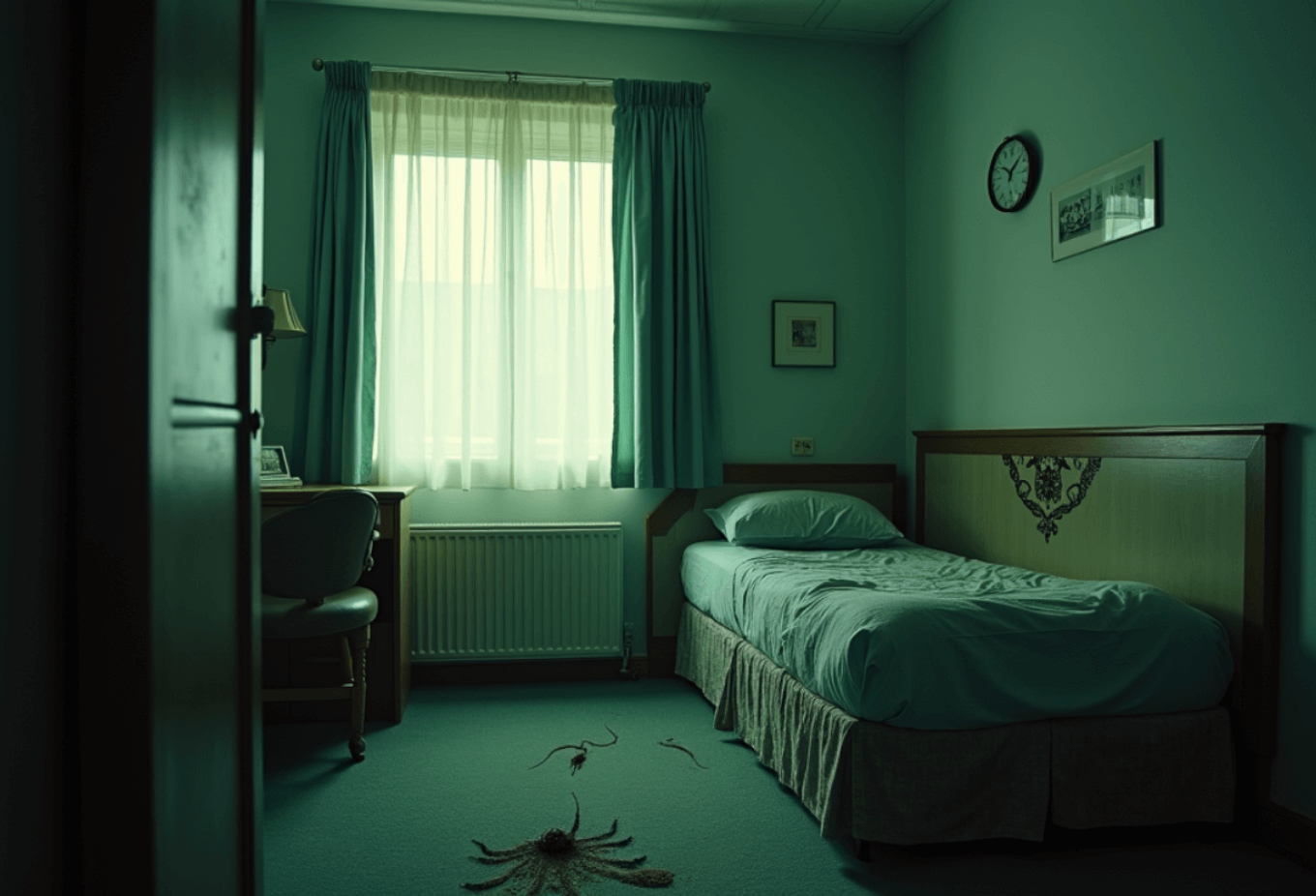Parasited Motel Malaise refers to a concerning phenomenon where travelers experience physical and psychological discomfort due to parasitic infestations in lodging facilities.
This troubling condition encompasses various health issues caused by unwanted guests like bedbugs, fleas, and lice that can transform a simple overnight stay into an unsettling experience.
The impact extends beyond just guest discomfort – it poses significant challenges to the hospitality industry through reputational damage and potential health risks.
Much like medical malaise, which creates a general feeling of unwellness, this condition manifests as both physical symptoms and a pervasive sense of unease that can affect travelers long after their stay.
The growing concern over this issue highlights the critical importance of proper sanitation and pest control measures in accommodation facilities.
The Origins of Parasited Motel Malaise
Historical Context
Parasited Motel Malaise emerged as a term describing the intersection of hospitality industry challenges and public health concerns. The concept combines “parasite” (organisms that live off hosts), “motel” (temporary lodging), and “malaise” (a general feeling of discomfort).
Environmental and Health Dimensions
The phenomenon reflects broader environmental health challenges in temporary accommodations. Similar to how wetland ecosystems affect human health through exposure to infectious diseases and toxicants, motels can become settings that impact guest wellbeing. Common parasitic threats include bedbugs, fleas, and mites that cause physical and psychological distress.
Cultural and Psychological Impact
The condition has both physical and psychological dimensions. Guests experience:
Physical symptoms: Itchy welts, allergic reactions, and skin irritations
Psychological effects: Anxiety, sleep disruption, and general unease
Scientific Understanding
Laboratory studies have shown that parasitic infections in confined spaces can spread through various exposure routes. The risk increases in settings with:
- High occupancy turnover
- Poor hygiene standards
- Inadequate maintenance
- Limited resources for pest control
Modern Context
Today’s understanding of Parasited Motel Malaise aligns with broader public health perspectives on mass gatherings and temporary accommodations.
Research shows that crowded venues with temporary facilities can increase infectious disease transmission risks. This particularly affects budget travelers who may have limited alternative accommodation options.
Symptoms and Signs of Motel Malaise
Physical Symptoms
Parasited Motel Malaise manifests through distinct physical symptoms. Guests often experience itchy welts, allergic reactions, and skin irritations from encounters with bedbugs and other pests. The discomfort typically intensifies during nighttime hours when parasites are most active.
Psychological Impact
The psychological effects are equally distressing. Visitors report experiencing:
Sleep disruption and insomnia
Overwhelming feelings of vulnerability
Persistent anxiety about safety
Environmental Factors
The physical environment plays a crucial role in triggering malaise symptoms:
- Dim lighting and narrow hallways
- Outdated architecture and visible decay
- Poor maintenance and unsanitary conditions
Progression Pattern
The experience typically follows a distinct pattern:
- Initial unease upon arrival
- Gradual awareness of physical discomfort
- Escalating psychological distress
- Peak symptoms within 24-72 hours of exposure
Long-term Effects
Many guests report lasting impacts beyond their stay, including:
Emotional trauma from the experience
Persistent fear of future accommodations
Physical aftereffects that may require medical attention
Causes of Parasited Motel Malaise
Environmental Triggers
The primary causes of Parasited Motel Malaise stem from poor facility maintenance and hygiene standards. Hotels spend an average of $6,383 per bed bug incident, with costs covering treatment, replacement of soft goods, and lost business. Common environmental factors include:
- Inadequate cleaning protocols
- Poor pest control measures
- Outdated infrastructure
- Insufficient ventilation
Physical Parasites
The most prevalent parasitic threats include:
- Bedbugs: Eight out of ten hotels dealt with bed bug issues in the past year
- Fleas: Often introduced through pet-friendly policies
- Mites: Cause severe skin irritations and respiratory issues
Psychological Impact
The condition creates significant mental health challenges for guests:
Social Anxiety: Guests experience increased stress and isolation
Sleep Disruption: Parasitic presence leads to insomnia and restlessness
Chronic Stress: Extended exposure can trigger long-term psychological effects
Social Factors
The transient nature of motel environments contributes to:
- Social Disconnection: Limited interaction with staff or other guests
- Cultural Displacement: Feeling out of place in temporary accommodations
- Safety Concerns: Inadequate security measures heighten vulnerability
Economic Influence
Financial constraints often force travelers to choose budget accommodations, where:
- Treatment costs can reach up to $23,560 per incident
- 40% of facilities require pest treatment monthly
- Nearly half face litigation due to infestations
Broader Implications and Symbolism
Modern Alienation
Parasited Motel Malaise represents a deeper cultural malaise and dissonance in contemporary society. The condition reflects a broader sense of existential uncertainty and social disconnection that characterizes modern life.
Mental Health Impact
The psychological toll is severe, with studies showing:
- 94% of temporary accommodation residents report mental health issues
- Common symptoms include isolation, paranoia, and chronic anxiety
- Residents experience persistent feelings of being caught in a trap
Liminal Spaces
Motels serve as ambiguous spaces between stability and homelessness, creating unique challenges:
Social Disconnection: Limited interaction creates isolation
Environmental Stress: Poor maintenance and cramped conditions trigger anxiety
Financial Pressure: Weekly payments create constant economic strain
Community Impact
The phenomenon affects both individuals and broader social structures:
- Cultural Displacement: Residents feel disconnected from their usual support systems
- Chronic Stress: Extended stays lead to long-term psychological effects
- Social Stigma: Residents face discrimination and feelings of powerlessness
Recovery Possibilities
Despite challenges, research shows that recovery is possible through:
Building informal support networks
Creating community connections
Maintaining personal autonomy
The experience represents a broader societal issue where temporary spaces become permanent fixtures in people’s lives, reflecting deeper problems of housing insecurity and social isolation.
Read More: Yeder Veyst: Unpacking the Meaning and Cultural Significance of This Iconic Yiddish Expression
Coping Mechanisms and Solutions
Personal Coping Strategies
To combat Parasited Motel Malaise, individuals can practice mindfulness techniques that help maintain mental equilibrium. Key practices include:
- Five-minute breathing exercises
- Active engagement in the present moment
- Non-judgmental awareness of surroundings
Creating Familiarity
Establishing a sense of personal space helps reduce anxiety in temporary accommodations. Travelers can:
- Bring familiar items from home
- Maintain regular routines
- Create designated areas for work and rest
Community Connection
Even in transient spaces, building social connections remains vital:
Join local community activities
Engage with other guests in common areas
Maintain virtual connections with family and friends
Systemic Improvements
Hotels can implement several measures to enhance guest experience:
- Install advanced air purification systems
- Implement antimicrobial surface treatments
- Provide contactless check-in options
- Enhance room consistency across properties
Environmental Modifications
Physical improvements that reduce malaise include:
- Improved lighting in common areas
- Enhanced cleanliness protocols
- Regular maintenance schedules
- Modern technological amenities
Professional Support
When needed, individuals should seek professional help through:
Online counseling services
Mental health apps
Support groups for frequent travelers
Regular check-ins with mental health professionals
Conclusion
Parasited Motel Malaise represents a complex intersection of physical, psychological, and societal challenges in temporary accommodations. The condition’s impact extends far beyond immediate discomfort, creating lasting effects on mental health and social well-being
While the hospitality industry faces significant financial burdens from this issue, with treatment costs reaching up to $23,560 per incident, the human cost remains immeasurableThe phenomenon highlights broader societal issues of housing insecurity and social isolation, serving as a mirror to modern alienation and displacement
However, recovery and improvement are possible through a combination of personal coping strategies, systemic changes, and community support
Success in addressing this challenge requires a coordinated effort from hospitality providers, health professionals, and guests themselves, along with an understanding of the deeper social implications that this condition represents


